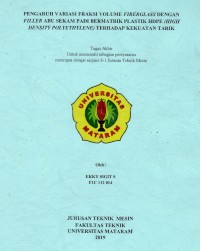
Tugas Akhir Mesin
Pengaruh variasi fraksi volume fiberglass dengan filler abu sekam padi bermatrik plastik HDPE (High Density Polyethylene) terhadap kekuatan tarik.
Nowadays, composite material is a preferred alternative for metal substitutes. One way is to utilize HDPE (High Density Polyethylene) from plastic wastes and rice husk ash as a composite material. Utilization of HDPE (High Density Polyethylene) (recycled) plastic waste, rice husk ash and fiberglass as composite reinforcement are expected to be a solution for automotive products for a lightweight and strong automotive bodywork. This study aims to determine the effect of fiberglass volume fraction with rice husk ash filler using HDPE (High Density Polyethylene) plastic as a matrix against the tensile strength of composites. The method is carried out by randomly aranging fiberglass an rice husk as a filler with a HDPE (High Density Polyethylene) plastic matrix. Fiber volume fraction of 20%, 30%, 40% and volume fraction of filler 35, 5%, 7% were made using the sintering method. Tensile specimen and testing procedures reffering to ASTM D3039 standard. The results of testing the tensile strength of the composite decreases with increasing variation in the volume fraction of fiberglass and volume fraction variation of rice husk ash filler. The highest tensile strength value occurs at 20% fiberglass volume fraction variation with 3% husk ash filler volume fraction variation and the lowest value at 40% fiberglass volume fraction variation with 5% variation in rice husk ash fraction each has an average tensile strength of 17.124 MPa and 9.726 MPa.
Ketersediaan
Tidak ada salinan data
Informasi Detail
- Judul Seri
-
-
- No. Panggil
-
621.384.Eky.p
- Penerbit
- Universitas Mataram : Fakultas Teknik Unram., 2019
- Deskripsi Fisik
-
xviii;66 Hlm;Illus; 21x29 cm
- Bahasa
-
Indonesia
- ISBN/ISSN
-
-
- Klasifikasi
-
621.384
- Tipe Isi
-
other
- Tipe Media
-
computer
- Tipe Pembawa
-
audio disc
- Edisi
-
Edisi 1 Jilid 1
- Subjek
- Info Detail Spesifik
-
Pengaruh variasi fraksi volume fiberglass dengan filler abu sekam padi bermatrik plastik HDPE
- Pernyataan Tanggungjawab
-
E.S. Sorenggana
Versi lain/terkait
Tidak tersedia versi lain
Lampiran Berkas
Komentar
Anda harus login sebelum memberikan komentar
 Karya Umum
Karya Umum  Filsafat
Filsafat  Agama
Agama  Ilmu-ilmu Sosial
Ilmu-ilmu Sosial  Bahasa
Bahasa  Ilmu-ilmu Murni
Ilmu-ilmu Murni  Ilmu-ilmu Terapan
Ilmu-ilmu Terapan  Kesenian, Hiburan, dan Olahraga
Kesenian, Hiburan, dan Olahraga  Kesusastraan
Kesusastraan  Geografi dan Sejarah
Geografi dan Sejarah